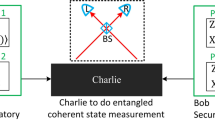Abstract
The decoy state scheme is the most widely studied quantum key distribution protocol to detect existence of eavesdropping. Twin-field quantum key distribution (TF-QKD) is a promising protocol for realizing secret key sharing over long distances. However, the secret key rate becomes relatively low considering the finite-size effect. In this study, the statistical fluctuation analysis of the four-intensity decoy-state TF-QKD system proposed in a recent study (Zhang et al. in Phys Rev A 95:012333, 2017) is considered, and its performance is compared with the results of the Gaussian approximation and Chernoff bound methods. Numerical simulations show that the suggested method shows a considerable improvement in both the key generation rate and transmission distance over the Chernoff bound method under actual experimental environment. We find that the scheme increases secret key rate 1.04–4.06 times and transmission distances 10–18 km farther. We also present optimized parameters for Gaussian, Chernoff, and our scheme.


Similar content being viewed by others
References
Bennett, C.H., Brassard, G.: Quantum cryptography: public key distribution and coin tossing. Theor. Comput. Sci. 560, 7–11 (2014). (Theoretical Aspects of Quantum Cryptography ?? celebrating 30 years of BB84)
Lo, H.-K., Chau, H.F.: Unconditional security of quantum key distribution over arbitrarily long distances. Science 283(5410), 2050–2056 (1999)
Shor, P.W., Preskill, J.: Simple proof of security of the BB84 quantum key distribution protocol. Phys. Rev. Lett. 85(2), 441 (2000)
Mayers, D.: Unconditional security in quantum cryptography. J. ACM (JACM) 48(3), 351–406 (2001)
Boaron, A., Boso, G., Rusca, D., Vulliez, C., Autebert, C., Caloz, M., Perrenoud, M., Gras, G., Bussières, F., Li, M.-J., et al.: Secure quantum key distribution over 421 km of optical fiber. Phys. Rev. Lett. 121(19), 190502 (2018)
Yin, H.-L., Chen, T.-Y., Zong-Wen, Y., Liu, H., You, L.-X., Zhou, Y.-H., Chen, S.-J., Mao, Y., Huang, M.-Q., Zhang, W.-J., et al.: Measurement-device-independent quantum key distribution over a 404 km optical fiber. Phys. Rev. Lett. 117(19), 190501 (2016)
Takeoka, M., Guha, S., Wilde, M.M.: Fundamental rate-loss tradeoff for optical quantum key distribution. Nat. Commun. 5(1), 1–7 (2014)
Pirandola, S., Laurenza, R., Ottaviani, C., Banchi, L.: Fundamental limits of repeaterless quantum communications. Nat. Commun. 8(1), 1–15 (2017)
Lucamarini, M., Yuan, Z.L., Dynes, J.F., Shields, A.J.: Overcoming the rate-distance limit of quantum key distribution without quantum repeaters. Nature 557(7705), 400–403 (2018)
Curty, M., Azuma, K., Lo, H.-K.: Simple security proof of twin-field type quantum key distribution protocol. NPJ Quantum Inf. 5(1), 1–6 (2019)
Lin, J., Lütkenhaus, N.: Simple security analysis of phase-matching measurement-device-independent quantum key distribution. Phys. Rev. A 98(4), 042332 (2018)
Cui, C., Yin, Z.-Q., Wang, R., Chen, W., Wang, S., Guo, G.-C., Han, Z.-F.: Twin-field quantum key distribution without phase postselection. Phys. Rev. Appl. 11(3), 034053 (2019)
Zhang, Z., Zhao, Q., Razavi, M., Ma, X.: Improved key-rate bounds for practical decoy-state quantum-key-distribution systems. Phys. Rev. A 95(1), 012333 (2017)
Ma, X., Qi, B., Zhao, Y., Lo, H.-K.: Practical decoy state for quantum key distribution. Phys Rev A 72(1), 012326 (2005)
Curty, M., Feihu, X., Cui, W., Lim, C.C.W., Tamaki, K., Lo, H.-K.: Finite-key analysis for measurement-device-independent quantum key distribution. Nat. Commun. 5(1), 1–7 (2014)
Wang, S., He, D.-Y., Yin, Z.-Q., Feng-Yu, L., Cui, C.-H., Chen, W., Zhou, Z., Guo, G.-C., Han, Z.-F.: Beating the fundamental rate-distance limit in a proof-of-principle quantum key distribution system. Phys. Rev. X 9, 021046 (2019)
Acknowledgements
This research was supported by the MSIT (Ministry of Science and ICT), Korea, under the ITRC (Information Technology Research Center) support program (IITP-2020-2015-0-00385) supervised by the IITP (Institute for information and communications Technology Planning and Evaluation). This work was supported by the National Research Foundation of Korea (NRF) grant funded by the Korea government (MSIT) (No. 2019R1A2C2010061).
Author information
Authors and Affiliations
Corresponding author
Additional information
Publisher's Note
Springer Nature remains neutral with regard to jurisdictional claims in published maps and institutional affiliations.
Rights and permissions
About this article
Cite this article
Park, J., Lee, J. & Heo, J. Improved statistical fluctuation analysis for twin-field quantum key distribution. Quantum Inf Process 20, 127 (2021). https://doi.org/10.1007/s11128-021-03035-x
Received:
Accepted:
Published:
DOI: https://doi.org/10.1007/s11128-021-03035-x




